Intersculpt 2007
Conseil Général de Muerthe et Moselle, Nancy, France; Arts et Metiers, Rue de L’hospital, Paris, France
Keith Browns’s Undulating Shapes
Digital Sculpture and Biomorphism
Conseil Général de Muerthe et Moselle; Nancy, France
October 10-17, 2007
Sculpture and Mathematics
Arts et Metiers, Rue de L’hospital; Paris, France
October 10-17, 2007
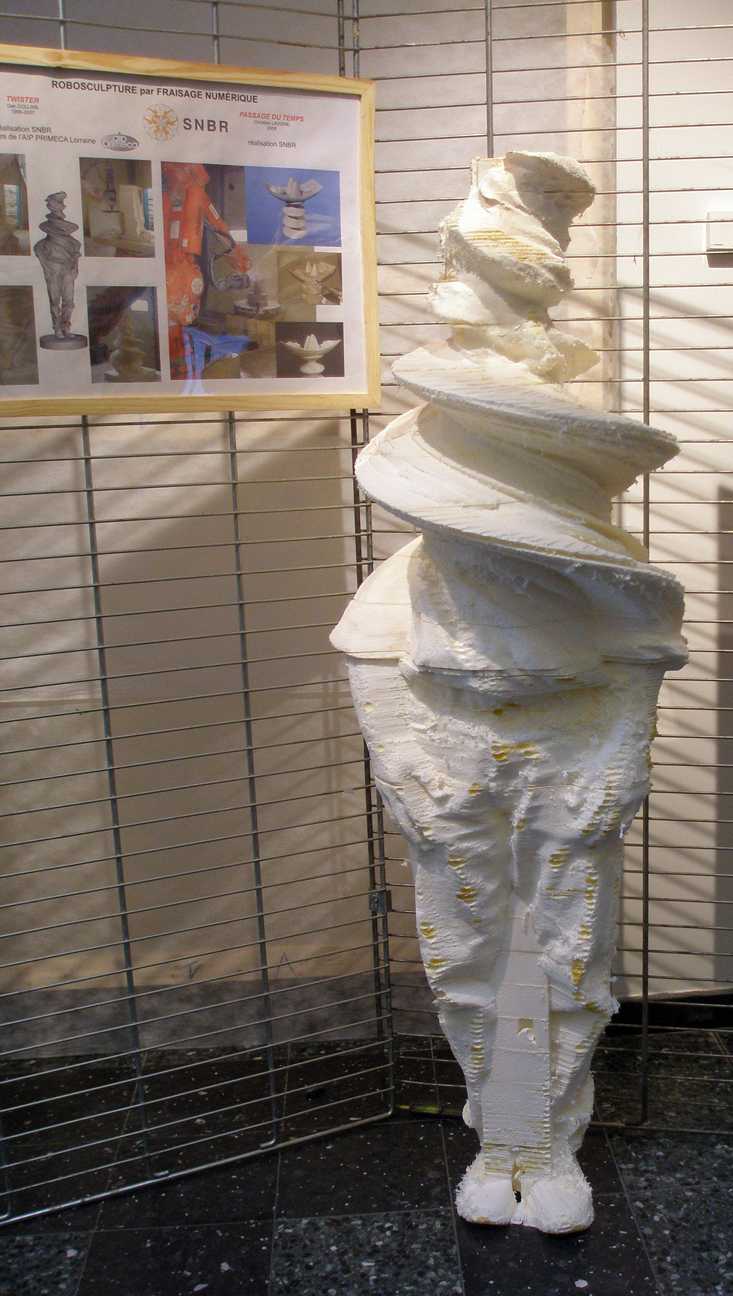
I was a part of this one, and went to France to participate in this exhibition and conference, part of a series of similar events that has been going on for several biennial cycles now. There were a wide range of presentations and works spread out over the week and two venues, and I missed the first day, but the parts I saw were pretty interesting.
The exhibition consisted of a number of vitrines containing small RP pieces, plus some larger pieces on plinths, and a nearly life-sized foam sculpture by Dan Collins’ “Twister” (a full-body scan of the artist twisted in a software program) that had been carved in France, using a robotic arm mounted with a rotary spindle, from a digital file sent from the USA. Many of the pieces in the cases, including mine, had been transmitted this way, by ftp file transfer, and were then built for the show in France by 3D printers. This is great from an artist’s point of view, eliminating hassles with art shipment companies and customs that take a lot of the fun out of showing sculpture abroad.
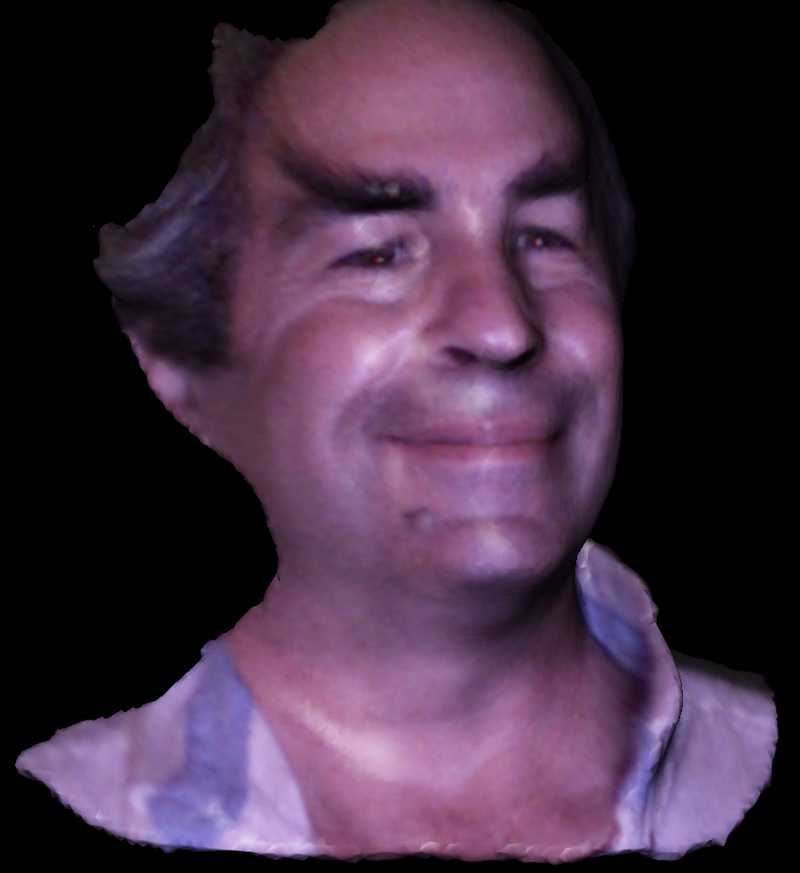
A couple of RP (Rapid Prototyping) machines were there, cranking out parts while we watched: a Z-corp machine that uses an incrementing powder-bed printed in layers with glue by an ink-jet process, and a Stratasys FDM (Fused Deposition Modeling) machine that’s more like a computerized hot glue gun, tracing contours with layers of two types of material, one for the model and another for the support structure that holds disparate pieces together during the building process. There was also someone with an Inspeck scanner, an instantaneous white-light device that’s specialized for the capture of human heads (an ancient tradition revived!) I let them do it to me; the results were frighteningly realistic—I’m thinking of using it for a Halloween mask…
The conference in Nancy, focusing on the biomorphic aspect of things, included some scholarly lectures (mostly in French) on such topics as Classical chimerae, used as decorative elements in Greek and Roman art, embryology and mythological monsters, advances in medical imaging, and theories of growth and form. There were also videophone presentations done from remote locations, featuring Derrick Woodham’s virtual sculpture park (with a section devoted to this exhibition; a high-bandwidth connection is recommended) where one could mouse around a simulated landscape and see various sculptures from different angles, like one does in the real world.
Another notable telepresence was that of Glenn Davidson from Artstation in Wales, U.K., who showed how large groups of volunteers could put together huge inflatable forms by plotting their edges on large rolls of paper laid out on the floor, using a self-propelled computer-controlled device they’d cobbled together (it resembled a lawnmower, actually, but worked admirably well). Once the machine had marked the paper, the shapes were cut out by hand and assembled with tape, then inflated to become very large and somewhat complex sculptural forms.
At the heart of the conference were the live presentations by individual artists. Christian Lavigne, the founder and organizer of the event, had a lot of new work to show, using various techniques including water-jet cutting, 5-axis milling, and color printing in 3D, which was a more impressive demonstration of this than I’d seen before. Using some new technology from Axiatec, a French company that has developed advanced methodology for using the Z-corp RP machine; he built a skull covered with images from his life and work, all of which was built and printed simultaneously. While I’d seen results from Z-corp’s color 3D printing process before, I didn’t realize that photographic imagery was possible, nor that it could look so good. They also seem to have worked out a way to ameliorate the rough grainy surface that had been the disappointing element in Z-corp’s otherwise promising powder-bed process; the pieces Christian and Mary Visser (more about her work later) produced for this show had smooth and subtly colored surfaces, quite ready for display as finished works of art. Apparently, a VRML file provides sufficient data to drive the color 3D printing process; I’m not sure if other formats can be used as well. I’m negotiating with Axiatec to distribute their technology in the USA; it makes a lot of things possible with RP that people have been wanting to do, but were unable to accomplish until now.

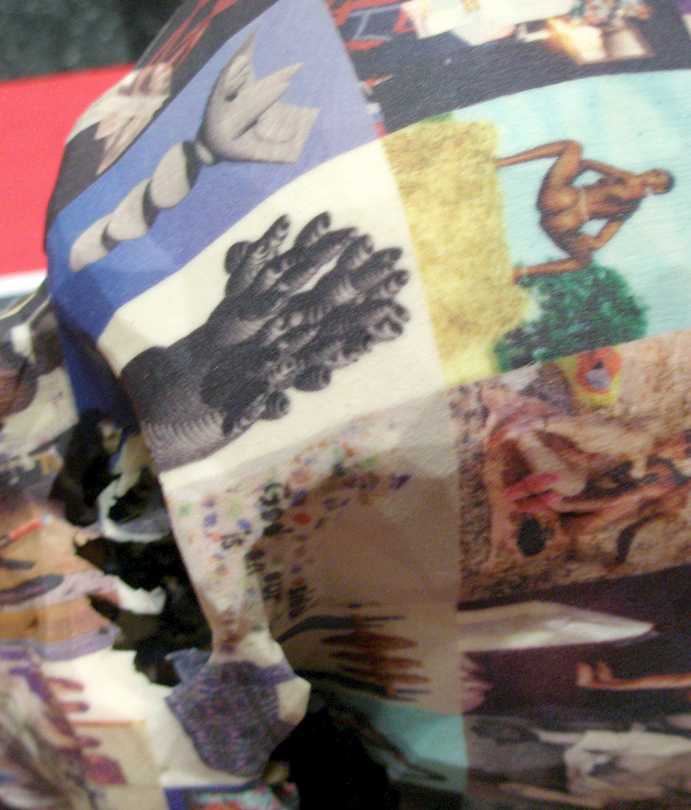
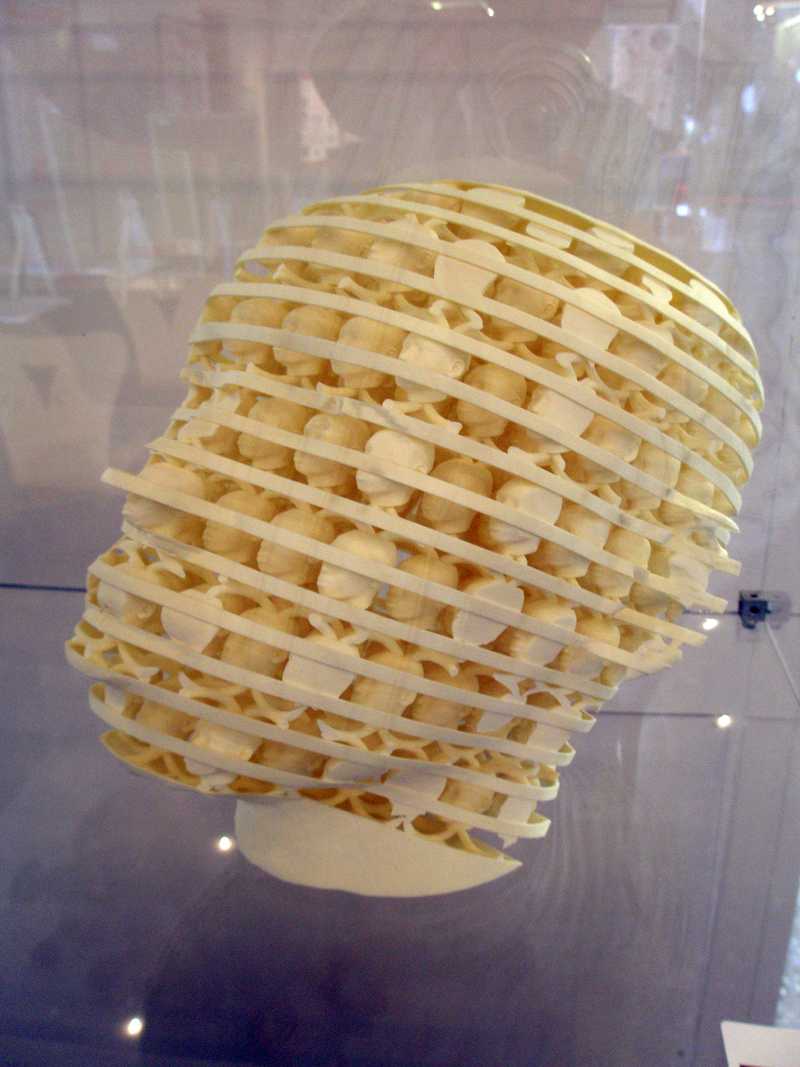
Works by Christian Lavigne
Patrick Vissenden from Montreal shared with us a fictitious phylum, creatures of an alternate reality he came up with by “Imagining Science”; building from the roots of science fiction. Having modeled a set of organic entities in wax, inspired by the fossils of the Burgess Shale and memories of Natural History displays; he scanned them in 3D, and stars them in a series of action photos from an apocryphal microbial battlefield.
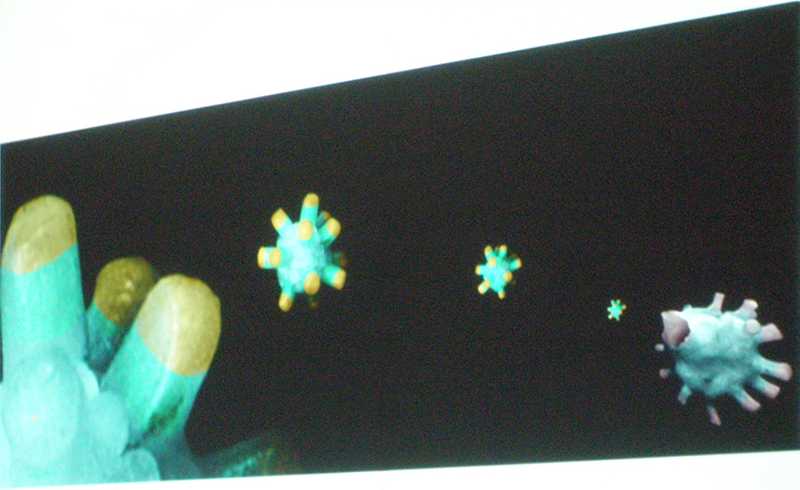
Jack Vanarsky, an Argentinean translated to France, showed us a movie composed by slicing and recombining the human face and figure; constantly reassorting its parts in a stately dance. He also produced a kinetic sculpture that reproduced the same effect; a sliced visage perturbed by a recurring motorized wavelike motion, like the shuffling of cards in the hands of an expert gambler.
Marcus Williams and his partner Sue Jowsey, both from New Zealand, looked inward to build their project, announcing it with a Maori chant and invocation. Dedicated to an intimate body-centered approach to art, they had scanned and photographed close-up details of their bodies: stubbly chin textures, hairy patches, and smooth downy expanses of flesh, mapping them to a loop of shifting organic shapes, a sculptural animation which was matched to an eerie vocal soundtrack created by modifying the recordings of Edith Piaf, the celebrated French chanteuse, to resemble an opera that may have been broadcast from Mars.
Ken Eward from Michigan based his series of works on Suiseki, the Chinese tradition of the “Scholar’s Object,” where specially selected natural objects, particularly rocks, would be mounted on polished wood bases to be contemplated like works of art. But Ken, trained as a scientist, looked to the realm of the electron microscope for his subjects, tapping particularly the aesthetic possibilities to be found in libraries of molecular models. The results may resemble bird’s nests, vertebrae or jellyfish, but they tap into a source of natural beauty unknown to most of us, and afford Ken a deep reservoir of forms that he can draw on for unexpected effects.
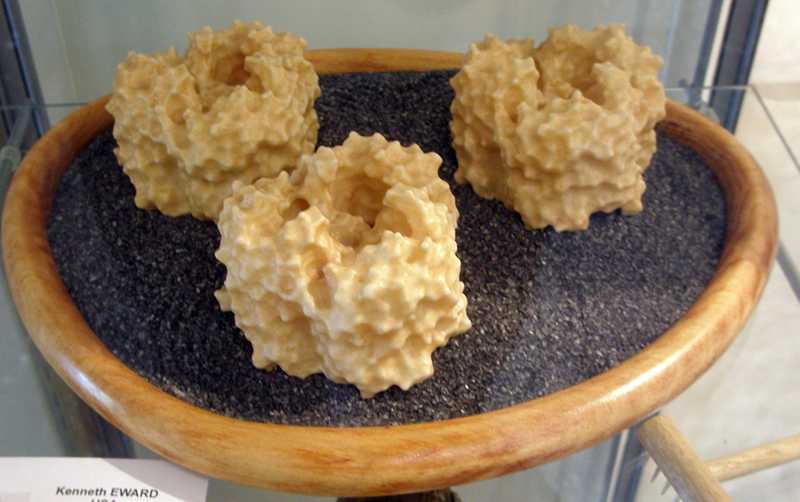
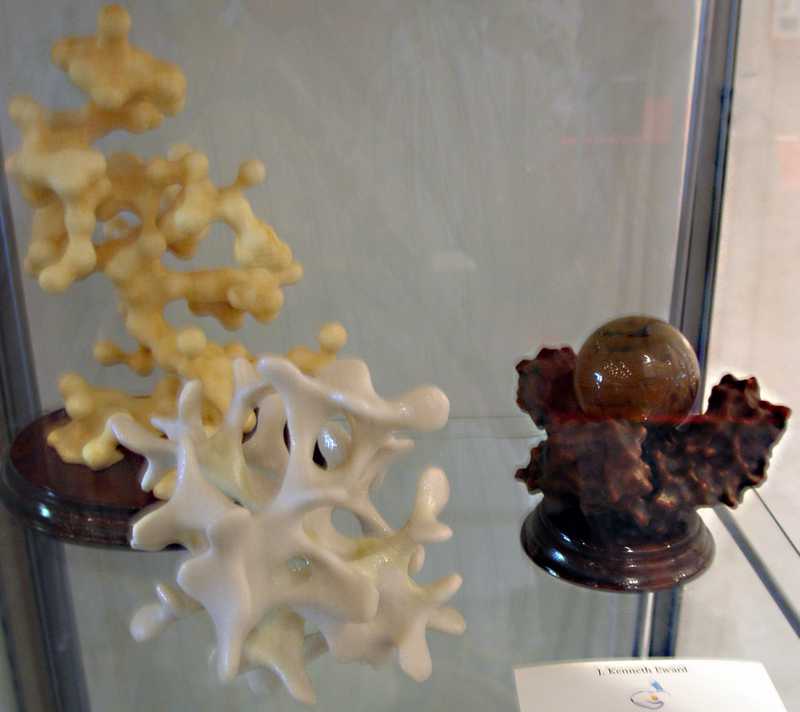
Ken Eward’s Micro-inspired Objects
Mary Hale-Visser came from Texas, where she teaches art at Southwestern University, to show us the latest developments in her work, which mostly concerns the female figure, considered as a sculptural element. She deals with harlequin jugglers and dancers holding each other up, or women seemingly caught in the wheels of machinery, enmeshed in arrangements not of their making but enjoyed none the less. A particularly striking piece referenced rebirth, through a series of boxes that connect old and new bodies or thoughtforms, darkly toned in a tour-de-force use of integral RP coloration, thanks to Axiatec’s leveraging of the Z-corp process. For her, computer technology has enabled the production of ideas that would necessarily have remained dreams if this direct route from the subconscious had not been available. Along with Robert Michael Smith, Mary also organized a highly influential 2003 show on RP and sculpture that toured several U.S. venues; Robert Michael Smith gave a tele-lecture the first day, which I missed, but some of his work is available on the Web.
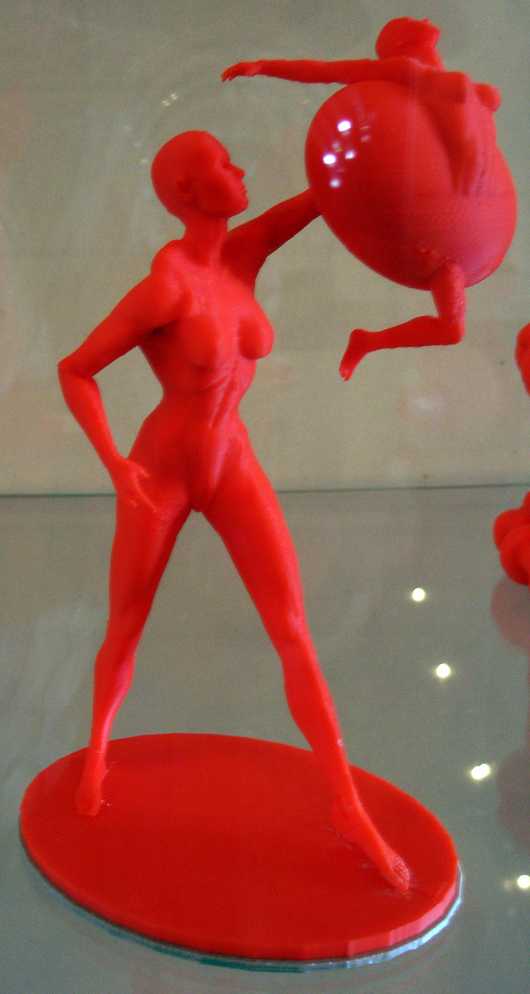
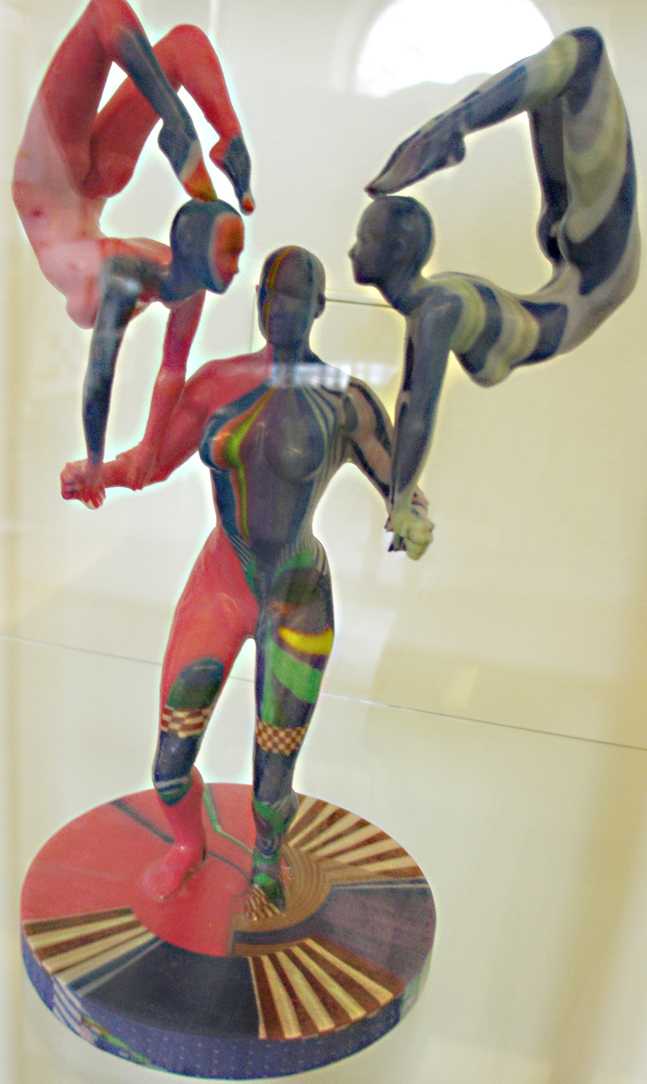
Mary Hale-Visser uses the female form as a sculptural element
Some other artists of note represented in the exhibition, whose presentations I also didn’t catch, were Stewart Dickson and Paul Higham, both pioneers in the field. Paul has worked out methods for extracting sculptural information from vast fields of numbers; his “Datasculptures” draw on sources like the Dow Jones Average, oil-field seismic studies and MRI data to produce solid objects resembling cityscapes, rocks, and spiderwebs; his self-generating sculptures are, theoretically at least, independent of the sculptor’s hand, needing only “intelligent design” to set them in motion. See virtualsculpture.org for more about him.
Stewart Dickson also got started early at this; his interest in the “concretization” of pure mathematics and his work for the film industry coming together in the early nineties to produce solid representations of classical mathematical figures like Fermat’s, Scherk’s and Enneper’s minimal surfaces cast in bronze. In this show I was struck by his snake-like “trefoil torus knot” built with integral color texture mapping. (I’d really like to see the 3D zoetrope in action…)
On returning from Nancy (a beautiful little city, by the way, with many examples of Art Nouveau architecture, several fine museums and a gorgeous 18th-century plaza) I stopped in at the Parisian part of the Intersculpt show, which dealt more with the mathematical than the biological foundations of sculpture. I was already familiar with the work of some other artists with work there, like Bathsheba Grossman, Jonathan Chertok, Rinus Rollofs, Keith Brown, and Brent Collins (in collaboration with Carlo Sequin).
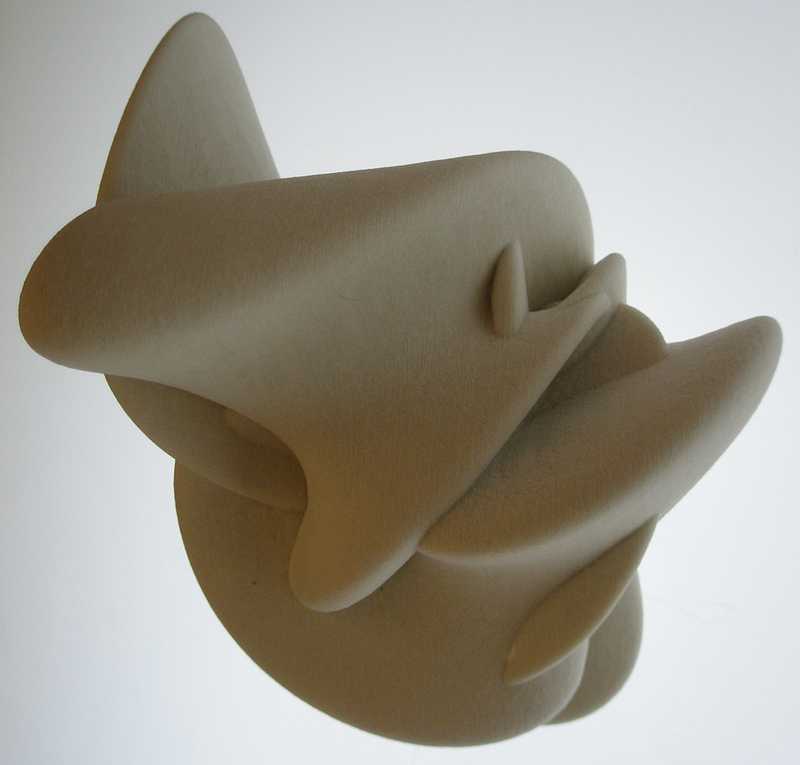
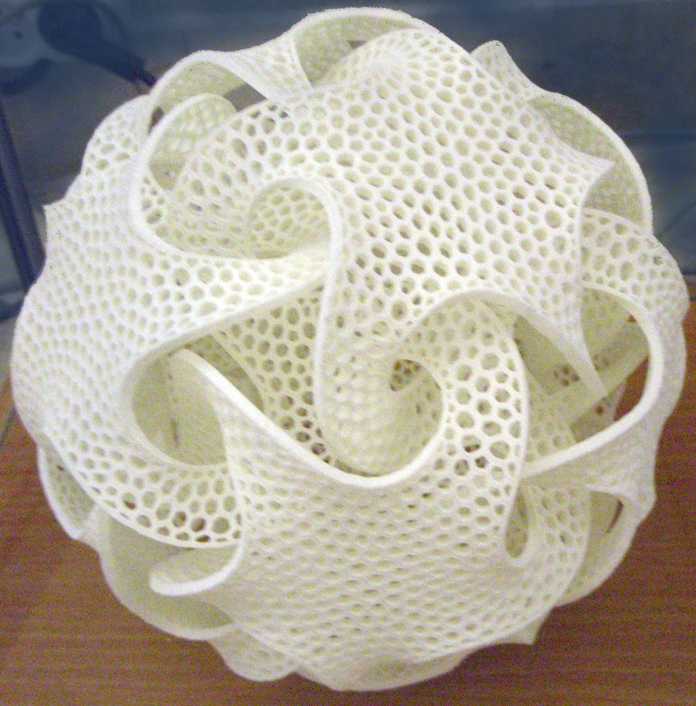
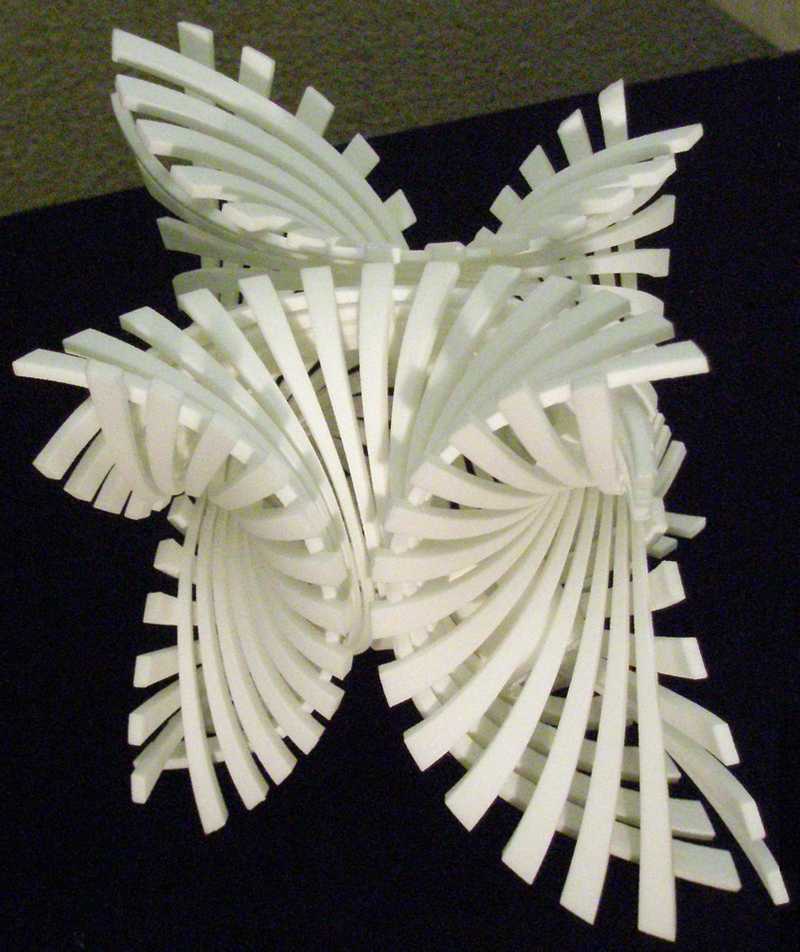
Works by Bathsheba Grossman built with RP machines
Bathsheba Grossman was showing some of her signature radially symmetrical topographies, built with RP machines.
Jonathan Chertok had some mysterious forms on display that suggested the negative spaces left when forms are subtracted.
Rinus Rollofs was displaying small versions of works he’s realized on a much larger scale, either crystalline arrangements of Platonic solids or variations on interpenetrating toroids.
Keith Brown had some complex organic pieces built in his seductive new style, featuring interpenetrating ovoids and softly undulating saddle shapes.
Brent and Carlo were working out the further mathematical implications of the sculpture Brent arrived at intuitively while carving in wood, which Carlo helped him to take to the next level.
Several of the sculptors represented in the show were there; I was fortunate in being able to speak with Alexandre Vitkine, who at 97–years–old qualifies as the Grand Old Man of the movement. He explained a little of his theories about simplicity, and how complex it can get when one adds a little perturbation to the formula for a simple shape. His carvings bore out his words: mostly done on a small CNC milling machine in wood, they exhibit elegance and a subtle sort of beauty I never got from Minimalist sculpture.
Some artists there were working out mathematical concepts in 3D without using machines to do it. Phillipe Charbonneau, for instance, put together curvilinear concentric revolving forms from linear elements (evidently the working out of mathematical formulae my French wasn’t good enough to fully understand). Phillipe Rips used very basic means—tubing and cable—to construct tensegrity structures that were quite stable when erected, but could easily collapse into a small bundle. Since his English was good, I was able to get from him a first-hand account of an artist’s life in France today (not as great as I’d thought) and much insight into other topics of interest, long into the night, at a sidewalk cafe, over numerous glasses of wine…
Andrew Werby Presentation at Intersculpt 2007
My presentation was about the evolution of my “Juxtamorphic” artwork from a manual process of making 3D collages using molds of natural objects to a more high-tech method of accomplishing the same thing; assembling 3D digital scans in a computer and outputting them at different scales in various materials with computer-controlled carving machines. Here are slides as a video. I also have an Acrobat PDF version and the text of my remarks are available below.
Andrew Werby’s Slide Deck from Presentation in Nancy, France. No audio.
Text of Presentation
I’ve always been fascinated by the myriad forms, textures and shapes of natural objects. I like art too, but there’s something about nature that hooked me early and hard. These things are endlessly fascinating; look closer and you see more, but no two are entirely alike. Effortlessly, Nature performs infinite variations on her themes. I feel that if we, as artists, are searching for the sources of beauty—and that seems to me what art at its best is about—then the obvious place to start is with Nature. Of course, I’m not the first artist to feel this way; from the beginning of art in the Paleolithic age, artists have tried to come to terms with the natural world that surrounded them, by replicating and modifying the things they observed. If art is considered mathematically, as a set of problems to be solved, then the forms of Nature are the axioms, the “givens” with which we must start with if we’re to come to an answer.
I started out in art by sculpting in ceramics and learned how to cast in bronze at the University. The process of making molds was fascinating to me, although it was considered incidental to the art of sculpture. I started making molds of all sorts of things, but what I liked most were natural objects. Fortunately, I was allowed to make molds from some of the objects in the departments of anthropology, geology, and paleontology; this jump-started my collection, which has since grown to include hundreds of molds of animals, minerals, and vegetables. I started combining these wax castings into sculptures, trying to make things that seemed all of a piece, like they had grown together naturally. I coined a term for this: Juxtamorphs, from Greek and Latin words for forms in close conjunction.
From the technique I had worked out for bronze, I was eventually able to extend my range to include other castable materials, like ceramics, plaster, paper pulp, and a new technique I developed which I call Sculpted Paint. This involves painting directly into the mold of a composite assemblage, and building up a skin in layers. It results in a strong and colorful but lightweight object that preserves all the detail of my master model. I got together with some other artists working along similar lines; we started showing together as the Juxtamorphic Art Movement.
Although I was exposed to computers at the time, I wasn’t interested in them; they seemed good for manipulating words and numbers, but I didn’t see their potential for making art. This changed in the early ’90s, when I started seeing what was being done with image-manipulation programs like Photoshop. I had done some 2D collage work, and this seemed the perfect means of producing them, without the tedium of cutting out pictures with a knife and the mess of pasting them up. I learned to do this, but 2D graphics just didn’t have the excitement of sculpture for me. I liked making real things, not just pictures of them. With an early 3D program, I figured out how to make some simple forms and cover them with photographic textures; this was more interesting than making totally flat art, but still the only way to realize it was to make prints. I wanted to make sculpture this way, but everybody told me that this wasn’t possible, at least not without spending hundreds of thousands of dollars I didn’t have.
Then I heard about a guy in Hollywood who had a 3D laser scanner that could capture the surfaces of any object placed on its turntable, and was able to get a few scans done from models—castings from natural objects—that I sent him. Unfortunately, every program I tried to open them in would crash or return an error when I tried to view them. Finally someone told me about a program, then in its pre-release beta testing phase, that might be the sort of thing I was looking for. Rhino made a lot of things possible that were just a dream before. I was able to open up my scans, and also to manipulate them in various ways: mirroring, scaling, cutting them up and reassembling them with parts of each other—this was my dream come true. Now, inside the computer, I could give my virtual models treatment similar to what my wax models received, but there it ended. Only in the 3D environment simulated by the program on a 2D computer screen could my combined objects be viewed.
But in the 1990s, computers were steadily becoming more powerful and widespread, and entrepreneureal manufacturers of hardware and software were taking note. A newly-introduced piece of software from the Netherlands, DeskProto, designed for non-machinists, became the route I found to connect the designs I was able to make in Rhino with the small cheap CNC mill I got to carve them out with. I’ll never forget the moment of triumph I felt, when I was finally able to see the crudely-carved but undeniably faithful copy of a scanned-in mollusk specimen, reproduced in wood, which proved my concept could work.
I soon got some scanning equipment of my own, first a Microscribe arm, that allowed me to capture forms by clicking on points in space, along the surface of the objects, creating curves that became surfaces. This was good for fairly simple forms, that didn’t have much texture I was interested in. The next scanning tool I got, one of Roland’s touchprobe scanners, although slower, was great at capturing fine details that the Microscribe couldn’t get. Then Roland came out with an inexpensive laser scanner, enabling me to collect surfaces all the way around an object, instead of only from one side. This came in handy, since I was just getting into 4-axis carving about then. With a rotary fourth axis, it’s possible to make sculpture in the round, since the workpiece is rotated as it’s being carved. The 4th axis is also useful for making rolling molds, like ancient cylinder seals, that can be used in ceramics, which provides a way to make larger pieces of art using small-scale machinery.
While the scale of a virtual sculpture is theoretically fluid, since the model can made larger or smaller as desired, in practice, it is constrained by the size of machine one has to work with. On my miniature CNC mill, the largest 3-axis part I can make is about 30 cm by 10 cm; the largest 4-axis part is about 30 cm by 7 cm in diameter. So I started looking around for a larger machine that would give me more capability. CNC machines come in two basic types: the router and the mill. Routers cut soft materials, like wood and plastic, and they tend to have short vertical axes to maximize their rigidity, so the things they produce are basically flat, with little vertical depth compared to their length and width. Milling machines are designed for cutting metal, so they are much more rigid, but the depth to which they will cut is constrained by the travel of their Z or vertical axis, as well as the length of the cutting tool. Although I purchased a CNC router and retrofitted an older-model milling machine with a modern PC-based controller, which increased my capability considerably, I kept dreaming of being able to make much larger pieces.
Since I could not find any machines on the market that would give me the ability to cut these large pieces, at least for a price I could afford, I decided to build my own. Starting with some surplus automation modules or “actuators”, which have the mechanical parts—ballscrews, slides, motors, etc. already mounted, we built a steel framework to carry them rigidly and provided a rotary table and tailstock for making large 4-axis parts. At this point, this machine is just about complete, but I haven’t yet cut any parts with it. It should make it possible to transcend the scale barrier, and carve some fairly large pieces, at least in foam.
At this point, most of my efforts have resulted in fairly small-scale work, using machinable wax, which can be molded for casting in other materials; wood, which has interesting color and material properties of its own; plastic, which can be clear, white, or colored; metal, which although slower to cut is useful in ways that other materials are not, since very long thin pieces will still be structural; and ivory nuts, the seeds of certain palm trees, which are hard enough to cut very smoothly and hold fine detail. Combining carved parts with cast parts gives me a wide palette of effects to choose from when constructing composite pieces. It seems like most of what I end up making are components, pieces of some larger thing that I may or may not have a clear vision of when I make the parts. It’s a lot like the process of assembling the individual pieces from natural forms; I can pick and choose from these units in order to construct a larger assemblage.
For me, the advent of inexpensive computer-enhanced 3D scanning, haptic modeling and CNC production techniques came at just the right time. It opened up new possibilities in the sort of work I was committed to already, increasing the sorts of forms I could deal with, the ways I could approach them, and the types of materials I could use. As an assemblagist applying for large commissions, I was stymied by the nature of my workprocess, which required me to work with full-sized parts. When a model was called for, the best I could do was a necessarily inaccurate sketch. Now, since I’m working in a scale-independent medium, I can produce a maquette that is accurate in everything but fine detail. At the other end of the size spectrum, my efforts in jewelry and objets d’art have been boosted by the availability of specialized CNC mills with high-speed spindles, and by addititve Rapid Prototyping machines that free the design from the limitations of the milling technique; now pretty much anything I can model can be realized in solid form, in a waxy material suitable for lost-wax casting. I really feel like an explorer who, after slogging through jungles, cutting my own trail, has come upon a vast and untouched territory, which calls out for discovery and further development.
Andrew Werby